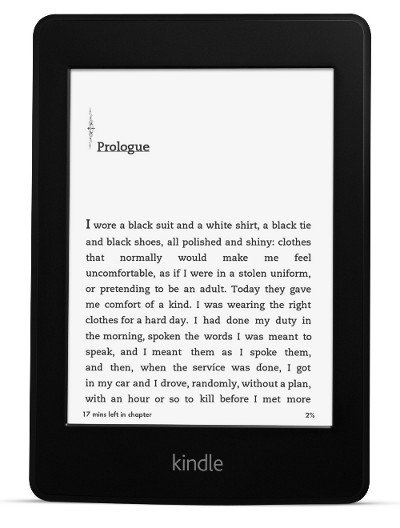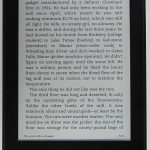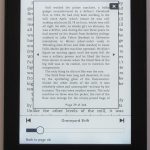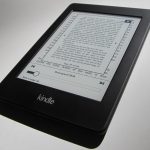Review Date: October 2013 – Review unit purchased from Amazon.com
Kindle Paperwhite 2 Review
Like with my recent review of the Kobo Aura, I’ve decided not to do a super-long detailed review for the 2nd gen Kindle Paperwhite because it’s 90% the same as the original Kindle Paperwhite from last year. I’ll cover the new features in this review, and I’ve put together an updated video walkthrough below, but for everything else please refer to the Kindle Paperwhite review from last year—just skip down past the video and the rest of the review still applies to the 2nd gen model just as much as the first, except the section about the frontlight.
I already posted an article about how the new Kindle Paperwhite has a much-improved frontlight, along with some thoughts on the new E Ink Carta screen tech. The only other two hardware upgrades include a faster processor, which does make the device a little bit quicker to respond, and a slightly tighter capacitive touchscreen grid, which I’m sure helps but I can’t tell any difference. Otherwise the two devices look identical and are the exact same shape and size.
From a software perspective, the new Kindle Paperwhite basically has three new features, with two more, Goodreads integration and Kindle FreeTime, coming at a later date. The first new feature is called Kindle Page Flip, which opens a window on the screen where you can scan through pages of the book using fast page-turning, jump from chapter to chapter, and skip around pages without leaving the initial page you started from.
The second new software feature is called Smart Lookup. They basically just changed the menus so then when you highlight a word, tabs for Wikipedia and X-Ray get added to the dictionary window. Also, if you highlight a name it will automatically open the X-Ray description instead of the dictionary.
The last new main software feature is a vocabulary builder. Every time you lookup a word in the dictionary while reading it gets added to a vocabulary list that can be accessed from the homescreen or settings menu. You can review the words on the list, delete them, mark them as mastered, look them up in the dictionary, and view flashcards to review the sentence where the word appeared. It’s a pretty cool new feature.
There are a couple of other subtle software differences too. Footnotes now open a new window instead of leaving the page. Bookmarks are handled differently than before. It’s now a two step process of tapping the upper right corner and then selecting to add a bookmark. And it now lists previous bookmarks when you tap the upper right corner, and if you tap on one it opens a window that shows its location without leaving the page.
These new software features and more are all shown in action in the video review at the bottom of this article. Here are a few pics:
Pros
- The frontlight is much better than last year’s model; the lighting is more evenly distributed and there aren’t any distracting discolorations. In fact my Kindle Paperwhite 2 has the best frontlight of any ebook reader that I’ve seen yet, and it has good range of bright and dim levels.
- The screen is clear and easy to read and provides a good reading experience in all lighting conditions, from completely dark to direct sunlight.
- Feels light in hand and is comfortable to hold for long periods.
- Less page flashing. Partial refresh has been extended to about 14 pages, meaning that’s how long before the E Ink screen flashes black. For some people this is a big deal, for others you can turn it off. At first I was noticing way more ghosting with partial refresh on, but now I don’t see ghosted text much at all. For a while my Kindle Paperwhite was acting strange by refusing to do partial refresh at all. After a few days and a couple of restarts partial refresh started working again, and now seems to do a better job. Maybe it wasn’t working properly in the beginning and that’s why I was seeing more ghosting. Who knows…
Cons
- Incremental update. If you are happy with the frontlighting on the original Kindle Paperwhite, there isn’t any reason to upgrade (there’s a good chance Amazon will update the software of the 1st gen to add the new software features since that’s what they’ve done in the past).
- No innovation. This is essentially the exact same Kindle that Amazon released last year. The screen is slightly better and the processor is slightly faster. Big deal.
- Still no ePub support or memory expansion—never going to happen anyway but still valid points.
- The alternate fonts trick no longer works. On the 1st gen Paperwhite it’s easy to sideload your own fonts, but the same method doesn’t work on the new Paperwhite.
- The 3G model got a $10 price increase from last year.
Verdict
On one hand the new Kindle Paperwhite is kind of disappointing. It brings nothing new to ebook readers and is basically just a carbon copy of the original Paperwhite from last year. On the other hand the new Paperwhite’s frontlight is much better than last year’s model and that alone makes for a more enjoyable reading experience.
Given the lack of competition in the US, Amazon doesn’t really need to do much to maintain their control over the dedicated ebook reader market. About the only other ebook readers left standing in the US are Kobo and Nook. Sony has stopped selling ebook readers entirely. Kobo has no retail presence, and B&N just took away most of the unique features from the new Nook that previously separated it from the Kindle.
Amazon doesn’t really have to do anything at all and they are still going to be gaining ground over the competition. I guess we should count ourselves lucky that they bothered to improve the Kindle Paperwhite at all; the basic Kindle hasn’t gotten any hardware upgrades in over 2 years, and the Kindle DX is a dinosaur.
Competition is dying out. Choices are dwindling. It would be great if companies could successfully stand up to Amazon and make things more competitive in the ebook reader space, but that doesn’t look like it’s going to happen. Amazon knows how to sell ebooks and make ereading easier and more convenient than anyone else. It’s not even close. That’s why the Kindle Paperwhite will continue to remain at the top of the ebook reader pyramid, and now that the screen is the best in the business things aren’t going to change any time soon. For me it’s clear that the 2nd gen Kindle Paperwhite is the best ebook reader on the market—and sadly that’s just going to stagnate innovation and competition even more.
Price: $119-$209 at Amazon
Kindle Paperwhite 2 Specs
- 6" E Ink Carta display.
- 1024 x 758 pixel resolution (212 dpi).
- Capacitive touchscreen with 2 point touch for pinch-zooming.
- Built-in LED frontlight for reading at night.
- 1 GHz processor.
- 2GB internal memory (1.25GB usuable).
- Wi-Fi 802.11 b/g/n.
- Optional 3G via AT&T’s 3G network in the US and partner networks outside of the US.
- Supported formats: Kindle Format 8 (AZW3), AZW, TXT, PDF, unprotected MOBI, PRC; HTML, DOC, DOCX, JPEG, GIF, PNG, BMP through conversion.
- Battery Life: 3-8 weeks.
- Weight: 7.3 oz – 206 grams.
- Dimensions: 6.7″ x 4.6″ x 0.36″ – 169 x 117 x 9.1 mm.





Nathan — Good review!! Note lack of physical page turn buttons should be added as a con for the Kindle PW. And I would love to see Amazon add expandable storage. Yes — agree this will probably never happen… 🙁
I’m hoping that innovation will continue outside of the U.S. I would also like to see innovation in the sub $100 e-readers. It has been over two years since Amazon or B&N updated their sub $100 models
BIG drawback of Amazon Paperwhite is that it doesn’t support text to speech!
Coming from a Kindle 5 NT, this looks like a nice upgrade for me. Oddly, your review is the ONLY one I’ve seen that demonstrates, or even mentions, the Page Flip feature and the new way of handling footnotes. These are really nice improvements for non-fiction readers like myself. I was hoping for a Kindle DX refresh this year, and more larger readers like that 13.3″ Sony, but the markets apparently have spoken.
hello,
nice review. I use my basic kindle for reading pdf scanned books which are not in English and it works well. I got new kindle paper white for being able to read in dark or low light conditions. To my disappointment new kindle do not show scanned pdf books as good as the two year old basic kindle or even the kindle keyboard shows. lots of letter are cut, disappearing, not showing properly, even text is not as sharp and good. sadly I shall have to stick the old kinlde. I do not know any software upgrade shall solve this problem or not.
The Goodreads integration creeps me out. Why? Because I interviewed with them and they are very creepy people. Lots of pathological narcissist types have entered the software industry and they are definitely present at Goodreads.
So, uh, high quality is a very bad thing, because it “stagnates competition”? This incredible statement is merely asserted. What tends to happen in markets, though, is that a business facing a superior product has a motive to improve his own product. In other words, competition encourages greater quality. No company has an automatic lock on future patronage, no matter how much better its current product may be than those of competitors.
I don’t suppose that in ten years we’ll get an update to this post in light of what has happened in the ereader market in the meantime. “Okay, I was wrong about the stagnation…”
You clearly have no grasp of the current dedicated ebook reader market in the US, which has been stagnating for over a year, and now things are getting worse than ever. A few years ago there were a dozen or more various brands and models of E Ink ereaders available in the US. Then the B&N and Amazon price wars flared up and chased away all the third-party options who had to charge more for their devices because they didn’t make money off of selling ebooks. Tablets came along and then the number of E Ink ereaders shrunk even more. Now Sony has given up selling E Ink ereaders in the US entirely. B&N is struggling to stay afloat and have just removed most the features from the Nook that make it unique. All that leaves to compete against Amazon is Kobo, a Canada-based company that doesn’t even make the US market a priority, as evidence by their complete and utter lack of retail presence and brand recognition (not many people in the US have heard of Kobo).
3 brands left standing. One is on life support. The basic Kindle has remained unchanged for over 2 years. This new Paperwhite is basically a carbon copy of the Paperwhite from last year. If you can’t see the stagnation in that then you’re looking at the wrong things. Dedicated E Ink ebook readers not named Kindle will be lucky to still be around in ten years.
I’d like to buy a 8″ or 9″ e-ink reader on which I can run programs I developed. I’d like to have high resolution display similar to Kobo’s Aura HD or Kindle Paperwhite [no I’m not a Retina display-fanatic but often have to read A/4 pdfs with small diagrams], also a decent built in frontlight and support for open formats. At some reasonable price.
Do you think Amazon will ever ship such units? Do you think that without competition it will ever be developed?
For 70% of the customers the Paperwhite is a good hardware with proper software and support for a reasonable price, but the rest will never get what they want without competition. So the problem for me is not the lack of competition but the lack of options.
Can you please post more info about viewing PDFs, maybe a video? Any improvements when you double tap a more complex PDF with different font size, maybe columns. Thanks
The lack of physical page turn buttons is a definite negative for the list as well as it’s lack of support for the most widely used ebook file format epub. The screen also has an unpleasant yellow-green background and is most definitely not ‘paperwhite’ the Carta eINK screen seems to have less contrast than the older pearl screen (as fitted to earlier Kindles and the Kobo Touch which (especially the latter) have a background closer to white and hence seem to display the text more crisply. Unfortunately, the Paperwhite seems only to display text at an acceptable quality when the light is switched on – this would seem to take away some advantage of using eINK over an illuminated tablet screen for reading. Paper books do not glow or light-up and are consequently feel easier on the eye – this is a great concern for many and possibly one argument for using ambient light based eINK in the first place!
I previously posted the fact that one can borrow a library book and have it downloaded to the Kindle Keyboard using the Kindle’s web browser provided you disabled Java in the browser settings. Otherwise, one would get a popup stating that Kindle could not open a new window. Starting with the Kindle Touch and now the Paperwhite, the browser was improved so that new windows would indeed open when required. This means that Java does not have to be disabled on these devices in order to borrow library books. One goes to his library website, checks out a book selecting the Kindle format, picks download now, and is taken directly to the Amazon website where one picks which Kindle to download to (if owning more than one) and then tapping “Get Library Book Now”. The process is seamless if one has previously signed in to the sites as the browser remembers login information. To be clear, this allows getting library books onto the Kindle Touch and Paperwhite, over WiFi, without having to use any other device. For people who have nothing but a Kindle, this is great to know as free WiFi is available at many locations.
In a note to Nathan, I suggest that you include this information in some future blog on getting free books in case there are those who do not read this reply to a previous blog.
Good point, Joe. I think I will do a blog post about it.
You need to update the specs to 4 GB of storage. Reading on Kindle Discussions, I found that amazon upgraded the initial storage from 2 to 4 GB after the Paperwhite 2 had been in production for a while. I would not buy a Paperwhite, if it had only 2 GB.